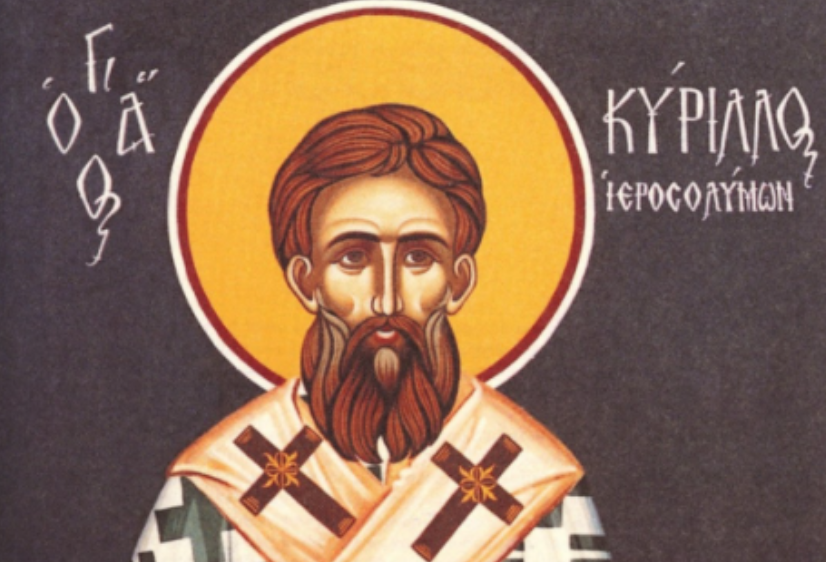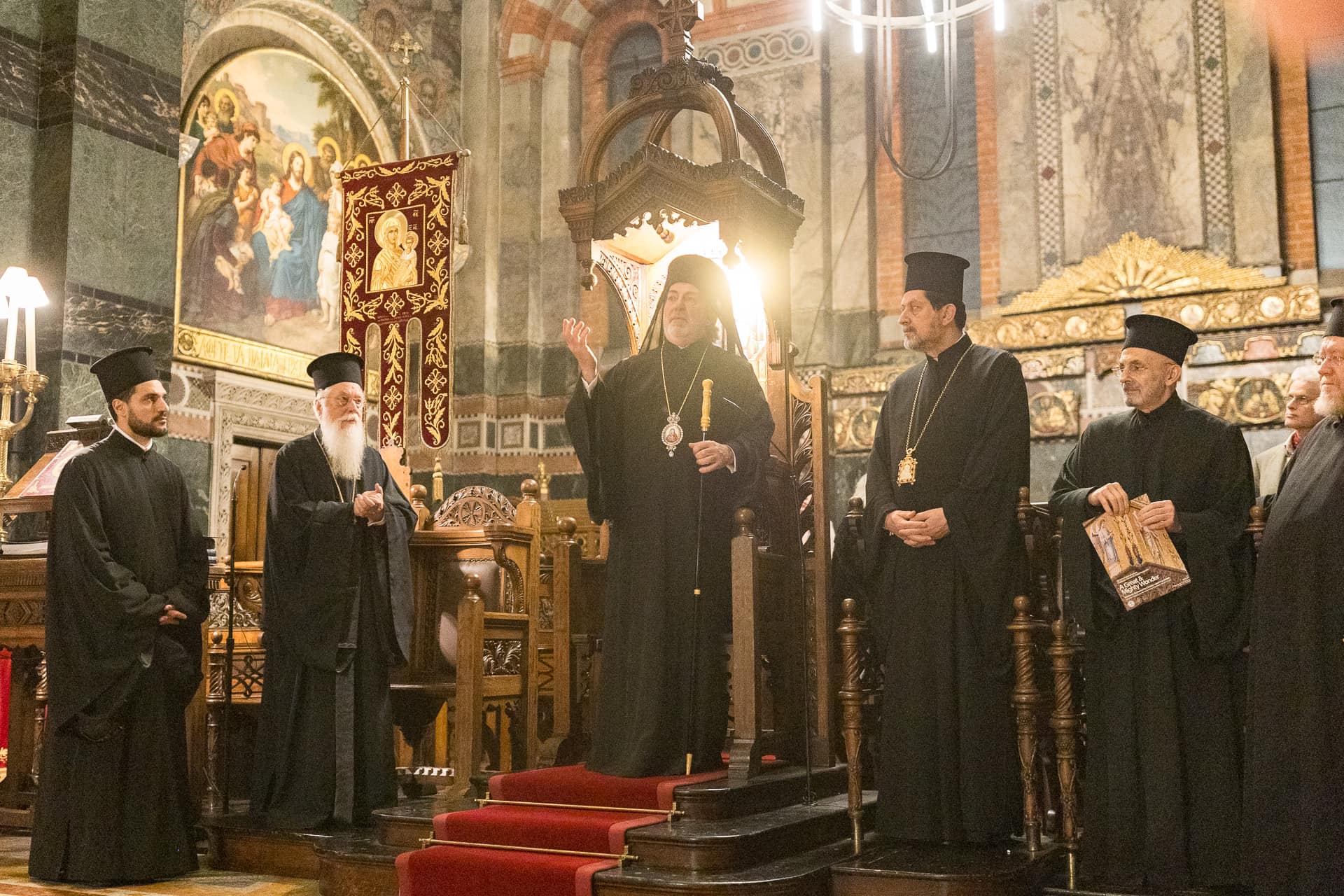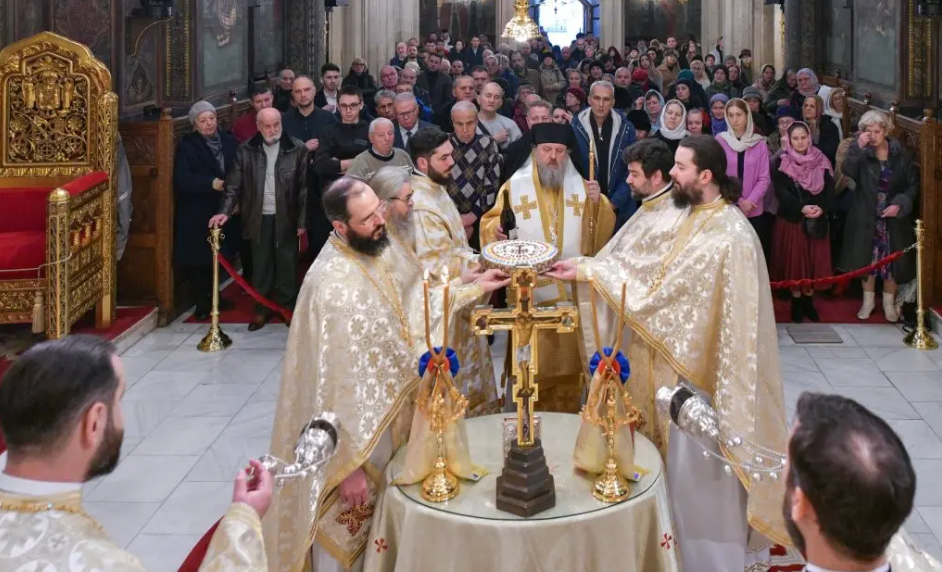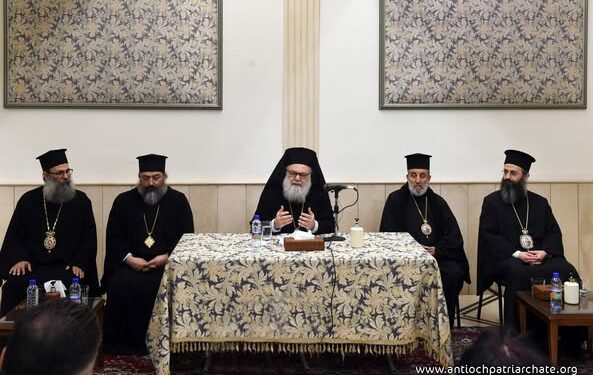Saint Cyril, Archbishop of Jerusalem (18 March)


Saint Cyril, Archbishop of Jerusalem, was born in Jerusalem in the year 315 and was raised in strict Christian piety. Upon reaching the age of maturity, he became a monk, and in the year 346 he became a presbyter. In the year 350, upon the death of Archbishop Maximus, he succeeded him on the episcopal throne of Jerusalem.
As Patriarch of Jerusalem, Saint Cyril zealously fought against the heresies of Arius and Macedonius. In so doing, he aroused the animosity of the Arian bishops, who sought to have him deposed and banished from Jerusalem.
There was a miraculous portent in 351 at Jerusalem: at the third hour of the day on the Feast of Pentecost, the Holy Cross appeared in the heavens, shining with a radiant light. It stretched from Golgotha above the Mount of Olives. Saint Cyril reported this portent to the Arian emperor Constantius (351-363), hoping to convert him to Orthodoxy.
The heretic Acacius, deposed by the Council of Sardica, was formerly the Metropolitan of Caesarea, and he collaborated with the emperor to have Saint Cyril removed. An intense famine struck Jerusalem, and Saint Cyril expended all his wealth in charity. But since the famine did not abate, the saint pawned church utensils, and used the money to buy wheat for the starving. The saint’s enemies spread a scandalous rumor that they had seen a woman in the city dancing around in clerical garb. Taking advantage of this rumor, the heretics forcibly expelled the saint.
The saint found shelter with Bishop Silvanus in Tarsus. After this, a local Council was held at Seleucia, at which there were about 150 bishops, and among them Saint Cyril. The heretical Metropolitan Acacius did not want to allow him to take a seat, but the Council would not consent to this. Acacius stormed out of the Council, and before the emperor and the Arian patriarch Eudoxius, he denounced both the Council and Saint Cyril. The emperor had the saint imprisoned.
When the emperor Julian the Apostate (361-363) ascended the throne he repealed all the anti-Orthodox decrees of Constantius, seemingly out of piety. Saint Cyril returned to his own flock. But after a certain while, when Julian had become secure upon the throne, he openly apostasized and renounced Christ. He permitted the Jews to start rebuilding the Temple of Jerusalem that had been destroyed by the Romans, and he even provided them part of the funds for the building from the state treasury.
Saint Cyril predicted that the words of the Savior about the destruction of the Temple down to its very stones (Luke. 21:6) would undoubtedly transpire, and the blasphemous intent of Julian would come to naught. Soon there was such a powerful earthquake, that even the solidly set foundation of the ancient Temple of Solomon shifted in its place, and what had been rebuilt fell down and shattered into dust. When the Jews resumed construction, a fire came down from the heavens and destroyed the tools of the workmen. Great terror seized everyone. On the following night, the Sign of the Cross appeared on the clothing of the Jews, which they could not remove by any means.
After this heavenly confirmation of Saint Cyril’s prediction, they banished him again, and the bishop’s throne was occupied by Saint Cyriacus. But Saint Cyriacus soon suffered a martyr’s death (October 28).
After the emperor Julian perished in 363, Saint Cyril returned to his See, but during the reign of the emperor Valens (364-378) he was exiled for a third time. It was only under the holy emperor Saint Theodosius the Great (379-395) that he finally returned to his archpastoral activity. In 381 Saint Cyril participated in the Second Ecumenical Council, which condemned the heresy of Macedonius and affirmed the Nicea-Constantinople Symbol of Faith (Creed).
Saint Cyril’s works include twenty-three Instructions (Eighteen are Catechetical, intended for those preparing for Baptism, and five are for the newly-baptized) and two discourses on Gospel themes: “On the Paralytic,” and “Concerning the Transformation of Water into Wine at Cana.”
At the heart of the Catechetical Instructions is a detailed explanation of the Symbol of Faith. The saint suggests that a Christian should inscribe the Symbol of Faith upon “the tablets of the heart.”
“The articles of the Faith,” Saint Cyril teaches, “were not written through human cleverness, but they contain everything that is most important in all the Scriptures, in a single teaching of faith. Just as the mustard seed contains all its plethora of branches within its small kernel, so also does the Faith in its several declarations combine all the pious teachings of the Old and the New Testaments.”
Saint Cyril, a great ascetic and a champion of Orthodoxy, died in the year 386.
This Saint was born in 315, and succeeded Maximus as Archbishop of Jerusalem in 350. He was zealous for the Orthodox Faith, and was a defender of the poor. He was exiled three times by the Arian Emperors Constantius and Valens. But after their death, he was recalled to his throne; he reposed in peace in 386. Of his writings, the most prominent are his catechetical lectures, which are considered the most ancient systematic summary of Christian teaching. Before Saint Cyril, there had been two dioceses, one of Jerusalem, and one of Holy Sion; under Saint Cyril, they were united into one bishopric. See also May 7.
Cyril was born in Jerusalem during the reign of Constantine the Great and died during the reign of Theodosius the Great (315-386 A.D.) He was ordained a priest in 346 A.D. and succeeded to the throne of Blessed Maximus, Patriarch of Jerusalem, in 350 A.D. On three occasions he was dethroned and sent into exile. Finally, during the reign of Theodosius, he returned but was not reinstated. He lived peacefully for eight years and then gave up his soul to the Lord. He underwent two difficult struggles: one against the Arians, who became powerful under Constantius, the son of Constantine, and the other during the reign of Julian the Apostate, against this traitor and the Jews. During a period of Arian domination, on the day of Pentecost, the sign of the Cross, brighter than the sun, stretched over Jerusalem and the Mount of Olives, lasting for several hours beginning at nine o’clock in the morning.
This phenomenon, seen by all the inhabitants of Jerusalem, was reported in writing to Emperor Constantius, and served greatly in establishing Orthodoxy over the heretics. During the time of the Apostate, still another sign occurred. In order to humiliate the Christians, Julian persuaded the Jews to restore the Temple of Solomon. Cyril prayed to God to prevent this. There was a terrible earthquake, which destroyed all that had been newly built. Then the Jews began restoration anew. Again there was an earthquake, which not only destroyed the newly constructed portion but also overturned and scattered the old stones beneath the ground that supported the Temple. And so the words of the Lord came true: There shall not be left one stone upon another, that shall not be thrown down (Mark 13:2; Luke 21:6).
Among the many writings of this Holy Father is his Catechetical Discourses, a first-class work preserved to the present, which confirms the Faith and practice of Orthodoxy. This saint was a unique archpastor and a great ascetic. He was meek, humble, exhausted from fasting, and pale in complexion. After a life of many labors and noble struggles for the Orthodox Faith, Cyril peacefully reposed and took up his habitation in the eternal court of the Lord.
Apolytikion of Cyril, Abp. Of Jerusalem
Fourth Tone
A model of faith and the image of gentleness, the example of your life has shown you forth to your sheep-fold to be a master of temperance. You obtained thus through being lowly, gifts from on high, and riches through poverty. Cyril, our father and priest of priests, intercede with Christ our God that He may save our souls.
Kontakion of Cyril, Abp. Of Jerusalem
First Tone
Thy speech inspired of God hath enlightened thy people to honour the One God, undivided in essence, yet known and distinguished in His Three Persons, the Trinity. Wherefore, with great joy we keep thy holy remembrance, and we have thee as our intercessor, wise Cyril, to pray unto God for us.
Source: oca.org / goarch.org / westserbdio.org





